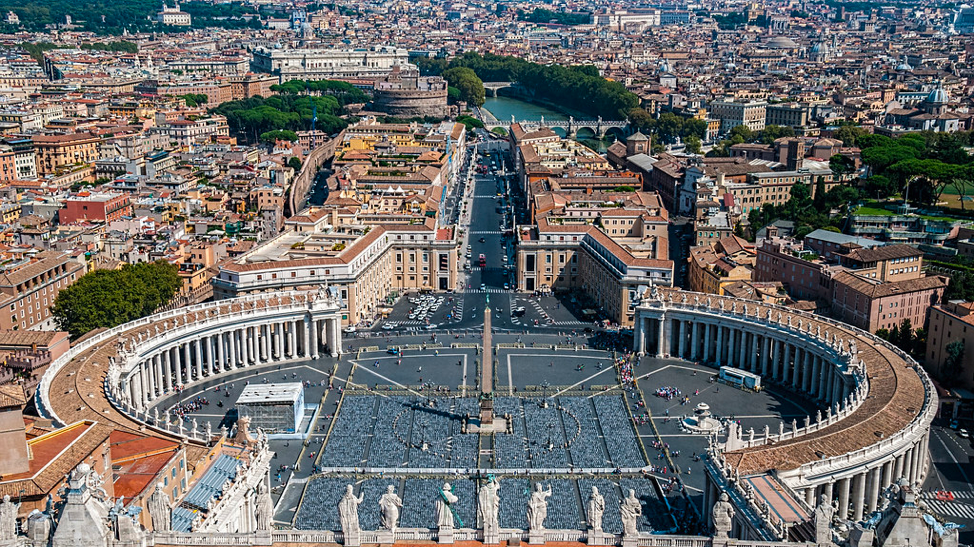By Lukas Hund
The smallest country in the world, Vatican City, is situated on the west bank of the Tiber River. Here lies the headquarters of the Roman Catholic Church, one of the largest and wealthiest organizations in the world. With over five million tourists a year, and only about eight hundred permanent residents, the country is like no other. Since 313 A.D, when the Catholic Church became the official religion of the Roman Empire, the power of the church has constantly expanded. Given the peculiarity of this country, you might wonder how its economy functions, and how it might compare to other countries. However, the Vatican’s economy is filled with secrets, conspiracies, and scandals, leaving the truth behind the country hard to uncover.
Although it is hard to find the exact numbers regarding the finances of the Vatican, there are multiple reports that shine a light on the possible economics behind the Holy See, the governing body of the country. To start, the Holy See generates revenue through something called Peter’s Pence. Since the 8th century, this has been the term used to describe the money received from donations by Catholics around the world, given to the Pope on an annual basis. The country also collects revenue through admissions to its museums, tours, highly sought-after stamps and coins, and the sale of publications. (Parker, 2021) Lastly, the Holy See also invests in companies and artifacts, hoping they appreciate in value. (CIA, 2022)
The coins mentioned above that are highly valued by collectors are minted within the walls of the city and are supposed to be financially equivalent to the euro. However, very few are made, causing collectors around the world to buy these coins imprinted with current and former Popes for significantly more than they are supposed to be worth. The history behind these coins is unique, as they were made due to the fact that the Vatican was not allowed to join the European Union, and thus could not use the euro as a form of currency. The main reason for their denial into the EU was because of their form of government. The EU requires all countries entering this pact to be democracies, but the Vatican is ruled by a monarchy, with the Pope acting as the king.
The Catholic Church is estimated to be worth about 30 Billion USD. (Bourke, 2018) Along with this, the Central Intelligence Agency’s World Factbook estimates the city had revenues of $315 million and expenditures of $348 million in 2013. However, after 2013, the Holy See has experienced a deficit estimated to be upwards of $30 million. This was primarily due to the decreasing price of gold, a valuable and largely held asset of the Catholic Church, not only in the form of gold bars but also in the massive amounts of precious metals that can be found in artifacts and buildings owned by the church.
Given the Vatican’s mass investments in artifacts, gold, and its dependence on tourism, the Vatican’s economy is extremely volatile. During the COVID-19 pandemic, tourism around the world was put on hold. With ticket sales down 75% last year, the Vatican lost an estimated $100 million. This forced pay cuts of 10% for cardinals, priests, and nuns working for the Holy See, and exposed the vulnerability of their economy. (Cerullo, 2021)
The Vatican pales in comparison to practically every other country when looking at purely GDP. Although the Holy See’s Nominal GDP is not published, the per capita GDP of the Vatican is estimated to be $21,198, making Vatican City the 18th wealthiest nation in the world per capita. (Kuznetsova, 2018) This is primarily due to the low population, with each person living in the Vatican being employed by the Holy See itself, avoiding national poverty altogether.
With the election of Pope Francis in 2013, the secrets of the Vatican are slowly being unveiled as he strives for public transparency to try and put the many scandals surrounding the church to ease. Through the years, people have accused the church of shady monetary practices, such as high ranking Italian officials and wealthy figures (or even mobsters) using the catholic church’s bank to avoid taxes. However, Pope Francis is determined to break away from the scandals of the past. His first step was appointing Australian Cardinal George Pell, who is determined to stop the laundering of money through the church and use their wealth to help in charitable ways. (Christensen, 2015)
When Catholics donate their hard-earned money to the church, they are hoping that it will go to a good cause. The Vatican hopes to use the money gained from these donations and its other business ventures to help the poor, provide medical aid to those in need through their many hospitals, and continue to spread their religion to more and more people around the world. This, in turn, will expand the wealth and power of the church, the Vatican, and the Pope himself, and ensure that the church remains a powerhouse for centuries to come. Although the secrets of this country are being slowly revealed, countless questions still remain unanswered, and the secrecy of the Vatican continues to leave Catholics in the dark.
References
Bourke, Emily. “Catholic Church Worth $30 Billion Nationally, Investigation Finds.” ABC News,
ABC News, 12 Feb. 2018, https://www.abc.net.au/news/2018-02-12/catholic-church-worth-$30-billion-investigation-finds/9422246#:~:text=Catholic%20Church%20national%20wealth%20estimated%20to%20be%20%2430%20billion%2C%20investigation%20finds,-The%20World%20Today.
Central Intelligence Agency, Central Intelligence Agency, 14 Apr. 2022,
Cerullo, Megan. “Vatican Has Lost More than $100 Million from Covid-19 Pandemic.” CBS
News, CBS Interactive, 1 Apr. 2021, https://www.cbsnews.com/news/catholic-church-vatican-lost-100-million-revenue-covid-pandemic/.
Christensen, John. “Is It Time to Assess the Financial Secrecy of the Vatican?” Tax Justice
Network, 7 Sept. 2020,
Kuznetsova, Olga. “.” Worldmark Encyclopedia of National Economies. . Encyclopedia.com. 25
Apr. 2022 .” Encyclopedia.com, Encyclopedia.com, 26 Apr. 2022, https://www.encyclopedia.com/places/spain-portugal-italy-greece-and-balkans/italian-political-geography/vatican-city#:~:text=Although%20it%20is%20the%20smallest,in%20the%20world%20per%20capita.
Morrison, Kristopher. “Wealth of Roman Catholic Church Impossible to Calculate.” National
Post, National Post, 9 Mar. 2013, https://nationalpost.com/news/wealth-of-roman-catholic-church-impossible-to-calculate.
Parker, Tim. “The Secret Finances of the Vatican Economy.” Investopedia, Investopedia, 27 July
2021,https://www.investopedia.com/articles/investing/030613/secret-finances-vatican-economy.asp#:~:text=The%20Vatican’s%20economy%20is%20shrouded,%2C%20bonds%2C%20and%20real%20estate.

